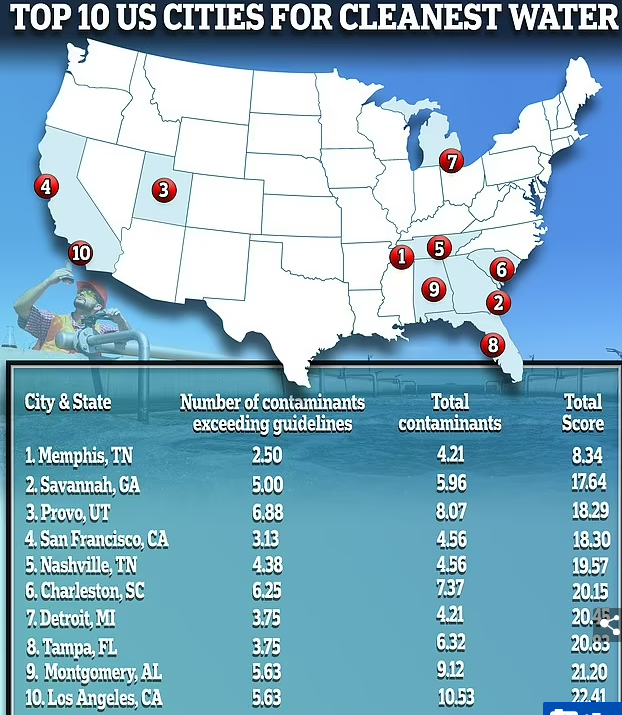The industrial city of Detroit was a surprising entry at seventh position while the coastal city of Tampa came eighth.
Montgomery, Alabama scored highly coming in ninth place while the second biggest city in the country rounded out the top ten.
At the bottom end of the chart, Newark, New Jersey reached 70th place just behind the desert city of Las Vegas at 69, home to 646,000 people.
The guidelines for water quality come from Environmental Protection Agency criteria, which was created with their scientific understanding of water pollutants and their impact on human health.
According to the study, it covers pH, alkalinity, hardness, and total dissolved solids.
The quality of Memphis’ water which topped the chart is said to be a source of city pride.
The drinking water comes from the Memphis Sand Aquifer, which sits hundreds of feet underground.
Fact: Despite advances in global sanitation, there are 187 countries where tap water is deemed unsafe or unpalatable
The aquifer is made up of a mixture of water and sand which helps to filter the water.
On top of the mixture is a confining layer made of clay which protects the aquifer from contaminants.
Water quality often features regularly in the news. In recent years, the trials of Flint, Michigan’s water contamination issues have dominated news headlines.
The crisis began in 2014 when the city began taking water from the Flint River for its 100,000 residents without treating it properly, resulting in lead contamination.
Residents complained about the water’s smell, taste and appearance raising health concerns, reporting rashes, hair loss and other problems.
As a result, the corrosive river water caused lead and other contaminants to leach from aging pipes into the drinking water. This led to elevated levels of lead and other pollutants in the tap water consumed by residents. The water was discolored, had a foul odor, and tasted unpleasant.
It wasn’t until independent studies and persistent activism by residents and researchers that the crisis gained national attention.
More recently, the train derailment in East Palestine, Ohio, released toxic chemicals that now threaten the local water supply.
Homeowners complained of symptoms that some in the town believe are tied to the release of chemicals from the derailed train cars.
The incident has also sparked environmental concerns. An estimated 3,500 fish died in creeks and rivers around the area although the Environmental Protection Agency have continued to assure residents their water supply is safe to drink.
This article was originally featured on “dailymail.co.uk”



























![The countdown is ON, Memphis! We’re officially 30 days out from the @unitememphis 5K + 1-Mile Walk/Run—and this year, we’re stepping into unity on 901 Day 🙌🏽
📍 Monday, September 1 | National Civil Rights Museum
🕘 Start time: 9:01AM
🎶 Food, music & fun to follow
Whether you’re walking or running, this isn’t just a race—it’s a movement. And there’s no better time to join in than now. 👟✨
🎓 COLLEGE STUDENTS: Be one of the first 100 to register using your .edu email with promo code NEXTGENUNITE and your ticket is just $10 (that’s a $32 savings 👀). Limit 2 per person, so tell a friend!
Let’s walk. Let’s run.
Let’s #UniteMemphis 💛
🔗 [link in bio]](https://wearememphis.com/wp-content/uploads/sb-instagram-feed-images/526805187_18335272954206022_6056852028660485499_nfull.webp)









